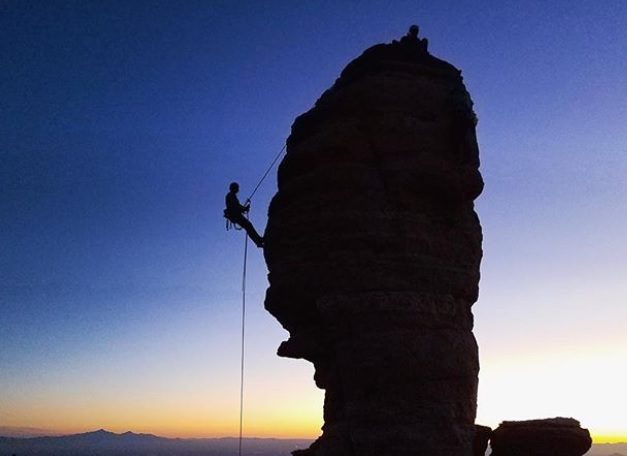Geotagging Mountains With Their Indigenous Names

Many mountains around the world have been stripped of their indigenous names and some climbers are giving them back.
Top alpinist Colin Haley has long been a climber that’s argued mountains should be referred to by their indigenous names, not their colonialist ones.
“Often the knowledge of indigenous names has become lost or muddled by lack of written history and often the same mountain was referred to by different names by different tribes,” Haley said.
Many mountain names in North America have colonialist names that have nothing to do with the geography or history of where it is. The names were merely given to peaks for political publicity, such as Mount McKinley.
Theodore Winthrop wrote in an 1862 article: “Kulshan, misnamed Mount Baker by the vulgar,… is an irregular, massive, mound-shaped peak, worthy to stand a white emblem of perpetual peace between us and our brother Britons.
“Its name I got from the Lummi tribe at its base, after I had dipped in their pot at a boiled-salmon feast. As to Baker, that name should be forgotten. Mountains should not be insulted by being named after undistinguished bipeds, nor by the prefix of Mt. Mt. Chimborazo, or Mt. Dhawalaghiri, seems as feeble as Mr. Julius Caesar, or Signor Dante.”
President Barack Obama officially changed the name of Mount McKinley to its indigenous name Denali in 2015.
But almost all other peaks with colonial names have not been officially changed. A few examples of indigenous names include: Sultana (AKA Mt. Foraker), Begguya (AKA Mt. Hunter), Tahoma (AKA Mt. Rainier), Dakobed (AKA Glacier Peak), Wy’east (AKA Mt. Hood), Pahto (AKA Mt. Adams), Loowit (AKA Mt. St. Helens) Kulshan, Nch’kay (AKA Mt. Garibaldi), Yuh-hai-has-kun (AKA Mt. Robson) and Cerro Chaltén (AKA Cerro Fitz Roy).
Haley points out that “it’s not easy to switch, and I catch myself all the time accidentally using the colonialist names, but I think it’s worth trying.”
Recently, a 29-year-old Navajo climber named Len Necefer started using social media to remind followers of the indigenous names of peaks.
Last year, he posted a photo of Monserrat A Matehuala standing on the summit of Longs Peak, one of Colorado’s best known 14ers.
The peak is very popular and instead of calling it Longs Peak, Necefer geotaged it as the peaks’ Arapaho name: Neníisótoyóú’u.
As Outsideonline.com reported, Necefer “earned his PhD in engineering from Carnegie Mellon and then began working for the U.S. Department of Energy’s Office of Indian Energy Policy and Programs.”
Last spring, Necefer founded Native Outdoors as an online campaign and it now makes clothing and works with larger brands to spread the message.
“The creation of the first national parks, like Yellowstone and Glacier, was predicated on the forced removal of indigenous populations from these areas,” saaid Necefer. “It created this myth that these are untouched wilderness areas.”
Necefer started to create new locations on Facebook and Instagram in 2017 after he climbed peaks in the Navajo Nation: Sisnaajini (Blanca Peak) in Colorado; Dookʼoʼoosłííd, Nuvatukya’ovi, and Wi:munakwa (the San Francisco Peaks) in Arizona; Dibe Ntsaa (Hesperus Mountain) in Colorado; and Tsoodził (Mount Taylor) in New Mexico.
After he couldn’t find the indigenous place names, he created them. Last fall, he and a group of other climbers climbed Mount Belford in Colorado’s Collegiate Range and tagged the mountain as Hiwoxuu Hookuhu’ee.
“The more I researched, the more I learned that there were a lot of first ascents by Native people.”
Necefer has now given 40 mountains indigenous names on social media. Likewise, Joseph Whitson, a non-Native student at the University of Minnesota started @IndigenousGeotags on Instagram.
“I think Len’s work is incredibly important,” Whitson says. “Restoring names is a way of reclaiming not just the peaks, but all the cultural significance embedded in the names themselves.”
As Outsideonline.com pointed out: “That effort is occurring offline, too. In Minnesota, for example, lawmakers plan to rename Lake Calhoun to its Dakota name of Maka Ska. In Washington, a proposal to rename Squaw Creek to Swaram Creek, its Methow name, has gained widespread support from both Native and non-Native groups, including the U.S. Forest Service.”
Names in Canada have been changing from colonial to indigenous for year. In 1984, the province of Alberta changed the name of Mount Laurie west of Calgary to also include its Stoney Nakoda traditional name Iyamnathka, which means flat-surfaced rock or mountain. It’s better known as Yamnuska.
In Squamish, the popular climbing area the Squaw was renamed Slhanay, which is what the peaks is known by in the language of the Skwxwu7mesh people.
And for those who don’t know, “squaw” is a bastardized pronunciation and spelling of the Algonquin word iskwew (pronounced es-kway-ew), which simply means woman.
There are many other examples of mountains being renamed from colonial titles to their indigenous.
“Once people see the names, they get curious,” Necefer said. “It gives you just a little bit of information and can spark the interest in finding out more.”


